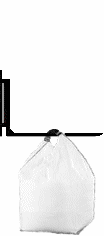|
|
|

|
Body
Construction |
 |
|
The basic bag shape consists of a square or rectangular base.
Sizing of bags very much depends on the purpose for which the bag
will be used. For instance, a common dimension for shipping containers
is 89cmx 89cm, however, 74cmx 74cm or 104 cm x 104 cm might be better
for rail freight. If just being used for storage, taller or wider
bags may be preferred.
Flexcon holds a wide range of fabric in different widths and grammage;
enabling us to supply out of stock or custom manufactured to your
requirements.
In bulk bags, working loads from 500kg to 2,000kg are possible and
fabrics are designed to meet a minimum of 5:1 safety factor. However,
denser and stronger fabrics for a safe working load of 6:1 or higher
can be manufactured. For hazardous materials, a variety of UN approved
bag designs are also available.
Fabrics woven with a breathing stripe allow the passage of more air
(necessary for products like potatoes) while maintaining the integrity
of the bag. Coated fabrics are suggested for use with either fine
powder products or those sensitive to moisture. Conductive
fabric and bag designs are available for products that form static
energy. |
| |
| Standard Four Loop Bag |
Two Loop |
One Loop Bag |
 |
 |
 |
| [ Click images to enlarge ] |
|
| |
| As the standard bag will round out on filling, a design has been
created which reduces this effect through the use of internal baffles
to provide tautness without in any way reducing capacity. This baffle
bag will cut down on space requirements, thereby also lowering freight
costs by as much as 30%. |
| |
| Baffle Bag |
Conical Bag |
 |
 |
| [ Click images to enlarge ] |
|
| |
| The conical bag is designed specifically to assist in complete
discharge of contents which are slightly sticky (like brown sugar). |
| |
 |
[ Lifting |
 |
] |
|
|


